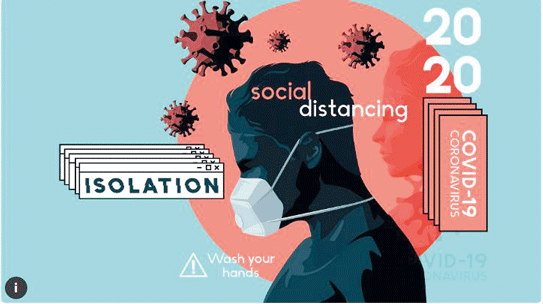AFFECTED: The mental health of the global population has been affected by the disruption of the traditional togetherness which is intrinsic to the human race.
The two year-long Covid-19 pandemic has affected not only the physical health of patients and the general public but also their mental health. The unnatural Covid-19 protocols which forced people to stay apart even if by one meter has destroyed the sense of community and social values.
By Anjuli Bhargava
In 1978, when the AIIMS postgraduate in charge of admissions read psychiatry to be the sole subject chosen by a student who to his mind could have easily specialised in any field of medicine, he summoned the young resident to explain. Who chooses psychiatry over surgery, paediatrics or medicine – all far more coveted fields? Who in fact wants to study psychiatry at all? The puzzled professor urged the young boy to reconsider his odd choice, or at least mention a second field if he remained adamant.
Shekhar Saxena added medicine as his second option at the behest of his professor and senior, but he had already made up his mind. The mind, in his view, was more fascinating, relatively unexplored, often treated as a peripheral subject and ignored both in terms of the understanding of the subject and the services available. It appealed to Saxena for its “humaneness” as opposed to other specialties, which deal with the body as this deals with the body and the mind. In that sense, he felt it was a more complete science.
Saxena and I connected over Zoom in late 2021 even as the pandemic raged and ebbed. I contacted him after hearing his public views and speeches on the crisis, where he stated more clearly than most that the biggest toll of this pandemic will be mental, not physical. Millions of lives had been lost but to his mind the mental effects of this crisis will remain with humankind for far longer. He was in his home in Geneva, although he had by then retired after 20 years with the WHO and was teaching at the Harvard T. H. Chan School of Public Health.
I began by asking him about one of the most disturbing trends in the last two decades. Many of us growing up in the 1970s and 1980s were unfamiliar with self-harm and suicides among children and young adults, but this has become quite commonplace now. I pointed out that when I was growing up, nobody had even heard of self harm, let alone of children taking their lives. In contrast, in Gurugram recently, a 22-year-old known to me jumped to her death from her condominium; those to whom I mentioned this sounded almost blasé about it, and in response reeled off the cases they knew of.
Even stranger is that this appears to be particularly true in more affluent circles of society, where every material need of the child is often met twice over.
Saxena laid out the basic facts first. Self-harm attempts and deaths among the young have increased globally but more so in India. India is already responsible for an increasing share of suicides: it hosts one-fifth of the world’s people but one-third of deaths by suicide. Such deaths in India are also heavily underreported due to the stigma; it is estimated that the actual number is 25% higher than that reported.
There are too many reasons to articulate in a single article, but Saxena argued that stress on children in several strata of society has increased manifold, including the more affluent, with their highly competitive environments exacerbating the problem. When Saxena was growing up, he said, if one got 70% marks in examinations, one was a “hero”, whereas now nothing less than 99% will do.
Pressure has also intensified with a lot of parents thrusting their own unfulfilled aspirations on the child. This leads to “hyper or helicopter” parenting, which makes matters worse. “Parents and children’s lives have become very closely meshed where the aspirations of each affect the other; a kind of diet where one is feeding the other,” Saxena explained, adding that the result is excess stress for both.
A lot of parents are also claiming to “advance” their children’s careers and being “gratified” as a result. This trend however is not peculiar to India: parenting pressures in China and Korea are typically worse than those in many other countries, and this often reflects in greater instances of self-harm.
A second problem is higher awareness and subsequently greater ambitions. “Children are far more aware of what they could be or what they could achieve and they feel aggrieved and deprived at the gap even when they are relatively well off,” Saxena said. This is fuelled a lot by social media but also by more exposure in all spheres of life. Comparisons with others also lead them to question their own self-worth at every stage.
Third, to his mind, there is today far greater acceptance of and willingness to address mental health issues. “Mental illness is far more talked about, people hear about it and it has become more acceptable, unlike in the past, when there was considerable stigma attached to it,” he said. There is a societal acceptance that these kinds of things can and do happen, unlike in the past, when it would have been looked at as “unacceptable”.
While Saxena agreed that mental stress has affected the more affluent in recent times, suicides are and remain quite common in less economically advantaged segments of society as well, where many children are subject to violence, abuse and deprivation of various kinds. These forces lead many children and young adults to attempt suicide, and a number of these instances also go unreported and unrecorded.
I interrupted to ask him which societies have been reporting the worst mental-illness crises. To me, the US seems in a particularly vulnerable state despite its better quality of life and material wealth, where recently four students at one college campus attempted to take their lives in a single month.
Social and economic factors play a big role, and it is established that those who are deprived or discriminated against have worse mental health. Since societies are becoming more unequal, the crisis has thus been deepening for the world at large. “Children of poorer families often face parental violence and abuse and their mental health is equally affected, even if they may not take their lives,” according to Saxena.
He added that there is a mental health crisis across the world and that it is getting worse. As far as this area of study and treatment is concerned, all countries are effectively developing countries, since none – not even the most economically developed – can boast of an adequate mental healthcare system. “Mental health is ignored and care is unavailable for prevention and treatment.”

The pandemic has made matters worse: it has affected not just those infected with COVID-19 but also everyone else, as many “life factors” changed as a result of our response to control its spread, like working from home and social-distancing. “Many of these changes may work for us in a short time frame, but some of the new realities may have a negative societal impact from a long term point of view,” Saxena said.
Mental health has to be seen as a dimension, or a spectrum, rather than as a binary that cleanly divides people who are well and people who are not. When he was studying psychiatry, Saxena said, they were told there were people who have a mental disorder – just like physical diseases – and people who are okay. But over the years, Saxena said he realised we are all on a spectrum with excellent mental health at one end and very bad mental health at the other, and that we move from one end to another in time.
There is no fixed state as such.
“So somebody in excellent mental health today may be in poor shape tomorrow or a few years later,” Saxena added. “In the pandemic, I would say all of us have moved.” What he found “frightening” was that anxieties and stress had multiplied for 95% of the world’s population during the pandemic, even as the world hadn’t prepared to support them.
“Forget the 5% who may have mental disorders they are grappling with – even the rest, who are in supposedly good mental shape, have been affected in this pandemic,” said.
It is this bigger realisation that made Saxena alter his own life’s trajectory. For 20 years, he looked after patient after patient at AIIMS from a clinical point of view, but he soon became acutely aware of the fact there were millions of people who needed mental health care and preventive services and who were outside his clinic. This led him to look at mental health through a wider lens, even though this remains a “less quantifiable” space.
In public health, he said, one could try 10 interventions and that eight could fail, while the one that succeeds could affect millions. He cited the example of suicide prevention interventions – like decriminalising certain activities or installing crisis helplines – at a society- or countrywide level, which could and has had a major impact in some societies.
I asked him to quote an example of his work at the WHO that gave him personal gratification. He recalled that in Ethiopia, he had been working with the government at a time when there were only two mental hospitals and where hospitals in general had few trained healthcare workers to recognise or treat mental disorders.
The Ethiopian government sought the WHO’s support and Saxena’s team subsequently trained 650 doctors and thousands of nurses over five years in hospitals across the country, to provide some level of mental healthcare. “The number of psychiatrists is and remains limited, but this intervention helped a large number” of people, he said.
What can India – both its government and its people – do to help people cope with COVID-19 and in general improve the country’s mental health situation as a whole? In India, the government is setting up health and wellness centres but these, Saxena said, should not become centres only for diseases but also address mental disorders. People staffing these centres need to be trained in mental health and recognise and provide care not just for those who have specific disorders but for everybody.
For example, Saxena said, if a patient comes in with high blood pressure, it is important not only to measure and monitor it but also to examine the root causes and understand the person’s job, family environment and stresses that could be playing on her mind. “So counselling along with drugs that counter hypertension would be a more holistic and desired approach,” he said. For any country, he added, it will prove “very expensive” to ignore mental health in the long run.
At an individual level, people can help by setting up self-help groups of the kind we see with cancer patients or cancer survivors, which deal with depression and so on. Providing an empathetic ear and not brushing mental health under the carpet are other steps that society or communities as a whole can encourage. As a popular saying goes, you don’t have to be a doctor to save lives.
Anjuli Bhargava is a senior business journalist.
Courtesy : Science The Wire
